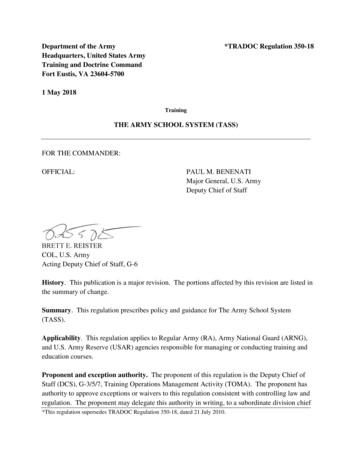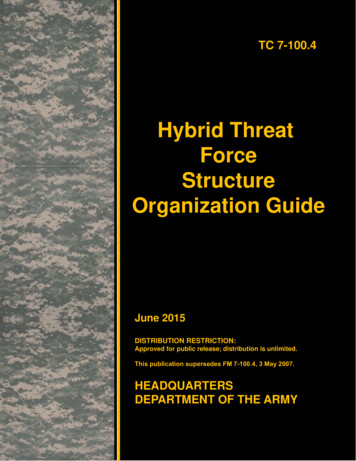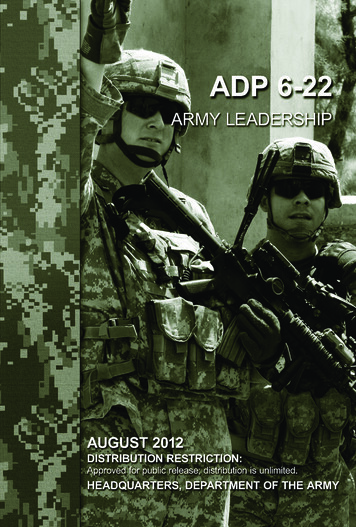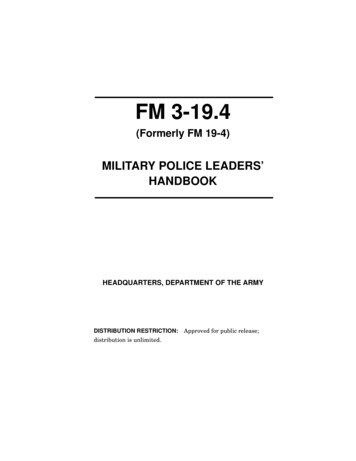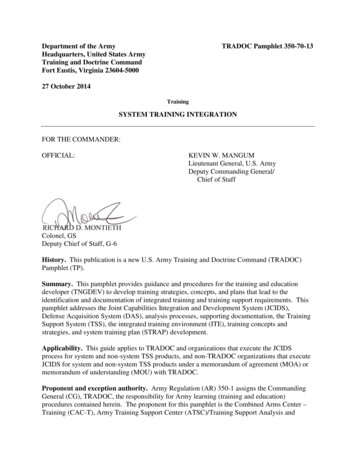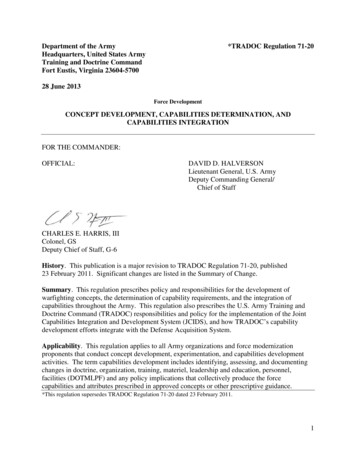
Transcription
Department of the ArmyHeadquarters, United States ArmyTraining and Doctrine CommandFort Eustis, Virginia 23604-5700*TRADOC Regulation 71-2028 June 2013Force DevelopmentCONCEPT DEVELOPMENT, CAPABILITIES DETERMINATION, ANDCAPABILITIES INTEGRATIONFOR THE COMMANDER:OFFICIAL:DAVID D. HALVERSONLieutenant General, U.S. ArmyDeputy Commanding General/Chief of StaffCHARLES E. HARRIS, IIIColonel, GSDeputy Chief of Staff, G-6History. This publication is a major revision to TRADOC Regulation 71-20, published23 February 2011. Significant changes are listed in the Summary of Change.Summary. This regulation prescribes policy and responsibilities for the development ofwarfighting concepts, the determination of capability requirements, and the integration ofcapabilities throughout the Army. This regulation also prescribes the U.S. Army Training andDoctrine Command (TRADOC) responsibilities and policy for the implementation of the JointCapabilities Integration and Development System (JCIDS), and how TRADOC’s capabilitydevelopment efforts integrate with the Defense Acquisition System.Applicability. This regulation applies to all Army organizations and force modernizationproponents that conduct concept development, experimentation, and capabilities developmentactivities. The term capabilities development includes identifying, assessing, and documentingchanges in doctrine, organization, training, materiel, leadership and education, personnel,facilities (DOTMLPF) and any policy implications that collectively produce the forcecapabilities and attributes prescribed in approved concepts or other prescriptive guidance.*This regulation supersedes TRADOC Regulation 71-20 dated 23 February 2011.1
TRADOC Reg 71-20Proponent and exception authority. The proponent of this regulation is the TRADOCDirector, Army Capabilities Integration Center (ARCIC)/Deputy Commanding General, Futures.The proponent has the authority to approve exceptions or waivers to this document consistentwith controlling law and regulations. Activities may request a waiver to this regulation byproviding justification that includes a full analysis of the expected benefits and must includeformal review by the activity’s senior legal officer. All waiver requests will be endorsed by thecommander or senior leader of the requesting activity and will be forwarded through higherheadquarters to Director, ARCIC (ATFC-O), 950 Jefferson Avenue, Fort Eustis, VA 236045767.Army management control process. This regulation does not contain management controlprovisions.Supplementation. Supplementation of this regulation is prohibited unless specifically approvedby the Director, ARCIC/Deputy Commanding General, Futures (ATFC-O), 950 JeffersonAvenue, Fort Eustis, VA 23604-5767.Suggested improvements. Users are invited to send comments and suggested improvements onDepartment of the Army (DA) Form 2028 (Recommended Changes to Publications and BlankForms) through channels to Director, ARCIC/Deputy Commanding General, Futures (ATFC-O),950 Jefferson Avenue, Fort Eustis, VA 23604-5767.Distribution. This publication is approved for public distribution and is available on theTRADOC Homepage at http://www.tradoc.army.mil/tpubs.2
TRADOC Regulation 71-20Summary of ChangeTRADOC Regulation 71-20Concept Development, Capabilities Determination, and Capabilities IntegrationThis major revision, dated 28 June 2013o Modifies U.S. Army Training and Doctrine Command’s requirements to comply with higherheadquarters revised guidance including use of Joint Capabilities Integration and DevelopmentSystem alternate formats specified in the Manual for the Operation of the Joint CapabilitiesIntegration and Development System. Updated guidance includes the Joint CapabilitiesIntegration and Development System, Chairman, Joint Chief of Staff Instruction 3170.01H, andthe Manual for the Operation of the Joint Capabilities Integration and Development System.o Updates doctrinal terminology (throughout).o Adds references to Army Regulation 5-22, The Army Force Modernization Proponent Systemas a key higher headquarters regulation which the U.S. Army Training and Doctrine Commandsupports (para 1-1).o Introduces the use of the Agile Capabilities Life Cycle Process as described in theHeadquarters, Department of Army standard operating procedure approved by the Vice Chief ofStaff of the Army (para 1-4).o Updates the organization of the Army Capabilities Integration Center (figure 2-1).o Adds Director, Army Capabilities Integration Center responsibilities for oversight of the Armycapability integration efforts and the validation of Army needs through the Network IntegrationEvaluations (para 2-10.).o Updates the document signed by the Director, Army Capabilities Integration Center thatprovides guidance for concepts and capabilities development, entitled “ARCIC Concepts andCapabilities Guidance (ArG)” (paras 2-10, 2-11, and 5-1).o Clarifies the role of the force modernization proponents across the Army in the areas ofConcept Development, Capabilities Determination, and Capabilities Integration from within theCenters of Excellence, Capabilities Development and Integration Directorates and non-U.S.Army Training and Doctrine Command proponent organizations (paras 2-14, 2-15, and 2-16).o Clarifies the role of Integrated Capabilities Development Teams as temporary teamingarrangements for capabilities development and documentation efforts and delineates thepermanent teaming arrangements supporting the U.S. Army Training and Doctrine Commandtwo-year cycle (para 2-14).3
TRADOC Reg 71-20o Clarifies U.S. Army Training and Doctrine Command Capability Manager commandrelationships (paras 2-16 and 2-20).o Updates the lead organization for the Training domain from U.S. Army Training and DoctrineCommand G-7 to U.S. Army Combined Arms Center (paras 2-16, 8-1, and 8-5; table 8-1).o Adds responsibilities and requirements to execute early analysis in preparation for an analysisof alternatives for a proposed solution (initial capabilities document) or a materiel requirement(capability development document/capability production document) (para 2-19 and 7-6).o Updates the Capabilities Integration governance principles and senior leader governanceforums used to support U.S. Army Training and Doctrine Command core functions (Chapter 5).o Updates the Capabilities needs analysis process (para 7-8).o Adds guidance on required training for capability developers in the Army (para 8-1 andAppendix D).o Adds clarification on how non-materiel requirements are handled and integrated (para 8-2).o Adds clarification that Combatant Commanders’ input for capability development efforts willbe included in proposed solutions and materiel requirements (para 8-9).o Adds mandated guidance from memorandum signed 31 August 2012 by Headquarters,Department of Army Deputy Chief of Staff, G-3/5/7 “Process to Introduce Requirement toMeasure Protection Factor of Shielding Against Low Level Radiation”, and the use of a draftcapability development document to inform the Technology Development Strategy and Requestsfor Proposals following the Milestone A acquisition decision (para 8-11)o Deletes mandated use of the Strategic Framework (para 8-13).o Updates Chapter 10 to reflect Rapid Acquisition/Rapid Equipping actions the U.S. ArmyTraining and Doctrine Command performs, to include the Agile Capabilities Life Cycle Process(para 10-4).4
TRADOC Regulation 71-20Table of ContentsPageChapter 1 Introduction . 91-1. Purpose . 91-2. References . 91-3. Explanation of abbreviations and terms . 91-4. Guidance . 9Chapter 2 Responsibilities . 12Section I Headquarters, TRADOC . 122-1. Commanding General (CG), U.S. Army Training and Doctrine Command (TRADOC)122-2. Deputy Commanding General (DCG), Futures . 132-3. TRADOC Deputy Chief of Staff (DCS), G-1/4 . 142-4. TRADOC DCS, G-2 . 142-5. TRADOC DCS, G-3/5/7 . 152-6. TRADOC DCS, G-6 . 152-7. TRADOC DCS, G-8 . 152-8. TRADOC Safety Office . 152-9. TRADOC Office of the Staff Judge Advocate (OSJA). 16Section II Army Capabilities Integration Center (ARCIC) . 162-10. Dir, ARCIC . 162-11. Deputy Director, ARCIC . 192-12. ARCIC Directorates . 202-13. Brigade Modernization Command (BMC) . 212-14. Chair, Integrated Capabilities Development Team (ICDT) or Force ModernizationProponent. . 21Section III Force Modernization Proponents . 232-15. Common responsibilities . 232-16. Centers of Excellence (CoEs) . 272-17. Commander, U.S. Army Combined Arms Center . 282-18. Commander, U.S. Army Combined Arms Support Command (CASCOM) and theSustainment CoE (SCoE). 29Section IV Separate TRADOC Activities . 292-19. Dir, TRADOC Analysis Center (TRAC) . 292-20. TRADOC Capability Managers (TCMs)/TRADOC Project Office (TPO) . 312-21. Commandant, U.S. Army War College (USAWC) . 32Chapter 3 Concept Development and Learning . 323-1. General. 323-2. Strategic guidance. 333-3. Operational environment . 333-4. Army Concept Framework (ACF) . 333-5. Development of Army concepts . 333-6. Concept of operations (CONOPS) and white papers . 343-7. Campaign of Learning (CoL) . 34Chapter 4 Requirements (Capabilities) Determination . 374-1. Capabilities development and integration in the Army . 375
TRADOC Reg 71-204-2. Joint Capabilities Integration and Development System (JCIDS) Application . 374-3. Alternative studies and paths into JCIDS . 384-4. Joint capability areas (JCA). 384-5. Army implementation of JCIDS . 394-6. Accelerated capabilities development . 404-7. Security and program protection . 40Chapter 5 . 41Capabilities Integration . 415-1. Overview . 415-2. Levels of integration construct . 435-3. Governance principles . 45Chapter 6 . 46Activities Supporting Concept Development, Capabilities Determination, and CapabilitiesIntegration Core Functions . 466-1. Modeling and simulation . 466-2. Studies and analysis (S&A) . 476-3. Experimentation. 496-4. Operational architecture development and integration . 516-5. Science and technology . 526-6. Scenarios . 54Chapter 7 Capabilities Analysis . 557-1. The Capabilities-Based Assessment (CBA) process . 55Section I CBA Steps . 577-2. Functional area analysis (FAA) . 577-3. Functional needs analysis (FNA) . 587-4. Functional solution analysis (FSA) . 59Section II Other Capabilities Analyses . 617-5. Conducting trades in a joint, resource constrained environment. 617-6. Analysis of alternatives (AoA) . 627-7. Requirements analysis (KPPs, KSAs, and performance attributes) . 657-8. Capabilities needs analysis (CNA) . 667-9. Warfighter outcomes analysis . 667-10. Cost-Benefit Analysis (C-BA). 667-11. Business case analysis (BCA) . 68Chapter 8 Documenting Resource-Informed Doctrine, Organization, Training, Materiel,Leadership and Education, Personnel, and Facilities (DOTMLPF) Solutions . 688-1. General. 68Section I Documenting non-materiel solutions . 718-2. Joint and Army DOTmLPF Change Recommendations . 718-3. Documenting doctrine requirements . 728-4. Documenting organizational requirements . 748-5. Documenting training requirements . 768-6. Documenting leadership and education requirements . 778-7. Documenting personnel requirements . 778-8. Documenting facilities requirements . 78Section II Documenting Materiel Solutions . 796
TRADOC Regulation 71-208-9. Documenting materiel requirements . 798-10. Initial Capabilities Document (ICD) . 808-11. Capability Development Document (CDD) . 828-12. Capability production document (CPD) . 858-13. Staffing, validation, and approval. 87Section III Critical Supporting Documents for Milestone B . 888-14. Basis for Milestone B . 888-15. Milestone B supporting documents . 898-16. Pre- Milestone B condition-based maintenance plus and common logistics operatingenvironment . 898-17. Pre-Milestone B AoA . 898-18. System training plan (STRAP) . 898-19 Operational Mode Summary/Mission Profile (OMS/MP) . 898-20. Basis of issue guidance . 918-21. Critical operational issues and criteria (COIC) . 918-22. Test and evaluation master plan (TEMP) . 928-23. System threat assessment report (STAR) . 928-24. Post Milestone B decision activities . 93Section IV Critical Supporting Documents for Milestone C . 938-25. Milestone C supporting documents . 938-26. Pre- Milestone C CBM and CLOE . 938-27. Pre-Milestone C AoA . 938-28. Updated STRAP . 948-29. Updated OMS/MP . 948-30. Basis of issue plan (BOIP). 948-31. Updated STAR . 948-32. Threat test support package (TTSP) . 948-33. Reliability failure definition and scoring criteria (FDSC) . 958-34. Post Milestone C decision activities . 95Chapter 9 Supporting JCIDS and Acquisition Activities . 959-1. Focus . 959-2. The Defense Acquisition Management System. 96Section I Pre-Milestone A. 999-3. The Materiel Solution Analysis Phase (MSA) . 99Section II Milestone A . 1009-4. Basis for Milestone A . 100Section III Milestone B . 1019-5. Basis for Milestone B . 1019-6. Pre-Milestone B AoA . 1019-7. Post Milestone B decision activities . 101Section IV Milestone C. 1019-8. Basis for Milestone C . 1019-9. Pre-Milestone C AoA . 1019-10. Threat test support package . 1019-11. Reliability failure definition and scoring criteria (FDSC) . 1019-12. Post Milestone C decision activities . 1017
TRADOC Reg 71-209-13. Interaction with Other Processes . 102Chapter 10 Rapid Acquisition/Rapid Equipping (RA/RE) . 10210-1. Focus . 10210-2. Capabilities development for rapid transition (CDRT) . 10510-3. Operational needs statements and the TRADOC review process . 10710-4. Agile Capabilities Life Cycle Process (ACLCP) . 108Appendix A References . 113Section I Required Publications . 113Section II Related Publications . 115Section III Prescribed Forms . 120Section IV Referenced Forms . 120Appendix B Requirements and Criteria for Capability Document Briefings . 121Appendix C Responsibilities Within Levels of Integration . 122Level 1 WfF & Special Concepts . 122Level 2 Requirements (Capabilities) Determination . 123Level 3 Integration across functions and/or DOTMLPF domains . 124Appendix D – Capabilities Development Training . 125D-1. DoD Level. . 125D-2. Army Level. . 127Appendix E. Phases of Capabilities Needs Analysis (CNA) . 128Glossary . 129TablesTable 2-1. AoA Guidance Coordination .21Table 7-1. CBA functions and responsibilities .56Table 7-2. Supporting analysis functions and responsibilities.64Table 8-1. TRADOC DOTMLPF domain leads with staff management responsibilities .70Table 10-1. Roles and Responsibilities in the Agile Capabilities Life Cycle Process (ACLCP) 110FiguresFigure 2-1. ARCIC organization.16Figure 3-1. Campaign of Learning Lines of Effort .35Figure 5-1. Concept-to-Capability framework .41Figure 5-2. Construct for the levels of integration.42Figure 5-3. Examples of Levels of Integration products .44Figure 6-1. Matching analysis types to stages of development .47Figure 7-1. CBA.55Figure 9-1. Relationship of the Defense Acquisition System to JCIDS .96Figure 9-2. JCIDS and the Defense Acquisition Management System .98Figure 10-1. Components of RA/RE .104Figure 10-2. Capabilities development for rapid transition process .105Figure 10-3. Agile Capabilities Life Cycle Process (ACLCP) Overview .109Figure D-1. RMCT Certification Training Levels .126Figure D-2. RMCT Course Descriptions .1278
TRADOC Regulation 71-20Chapter 1Introduction1-1. PurposeThis regulation assigns responsibilities and establishes policies that U.S. Army Training andDoctrine Command (TRADOC) and non-TRADOC proponents must follow to developconcepts, conduct experiments, identify gaps in capability, and develop doctrine, organization,training, materiel, leadership and education, personnel, and facilities (DOTMLPF), and policysolutions to address gaps requiring mitigation or closure. This regulation implements the JointCapabilities Integration and Development System (JCIDS) as outlined in Chairman of the JointChief of Staff Instruction (CJCSI) 3170.01 and the Manual for the Operation of the JCIDS(hereafter referred to as the JCIDS Manual). It describes how TRADOC supports the DefenseAcquisition System as outlined in Department of Defense Directive (DoDD) 5000.01,Department of Defense Instruction (DoDI) 5000.02, and Army Regulation (AR) 70-1. Finally, itdescribes how TRADOC supports AR 71-9, Warfighting Capabilities Deter
Department of the Army *TRADOC Regulation 71-20 Headquarters, United States Army . Training and Doctrine Command . Fort Eustis, Virginia 23604-5700 . 28 June 2013 . Force Development . CONCEPT DEVELOPMENT, CAPABILITIES DETERMINATION, AND CAPABILITIES INTEGRATION . FOR THE COMMANDER: OFFICIAL: DAVID D. HALVERSON . Lieutenant General, U.S. Army

